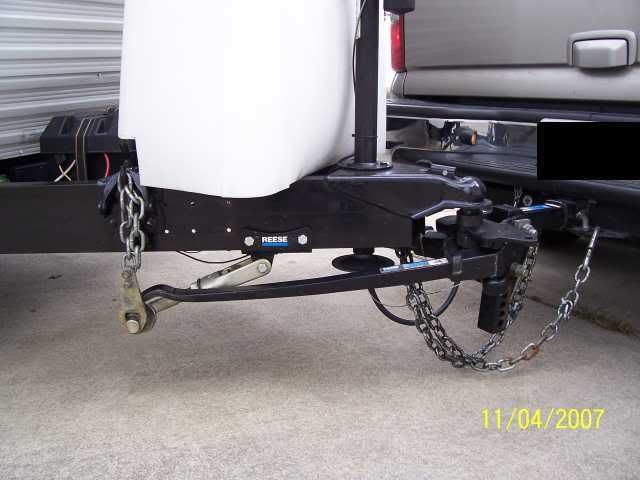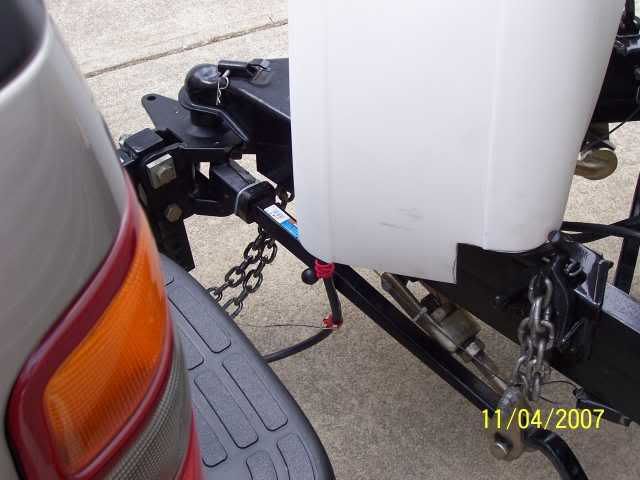Ron,
Great post! And yes, amazing to see the magnification up of the 500# force. I'm assuming you just picked the 500# as a number to use in the calculation not knowing actual loaded TW's and TV/TT stats. If this correct?
Let me add some to that picture and maybe you can carry this to the next level. The TT picture is from my current camper when I had my K2500 Suburban. I will list setup parameters when that picture was taken. A few points to note, as you can see (concrete speckles under the camper) I was turning around on my concrete pad in my drive way. The concrete was level however the hitch head had some left to right tilt. That turn is the physical mechanical limit of the Suburban and hitch on a hard left turn. It was approx 74 degree left. If I went any further I would of broke the hitch.
Something I now see since that pic was taken, and may add to this topic of increasing chain forces on one side of the A frame even on level ground. You can see the hitch shank it tilted when the truck was on level concrete. The large tension on the right side of the A frame appears to be rolling the shank and possibly the truck a little. The shank for sure has a CW tilt as viewed from the TT. With your recent found force magnification in this extreme turn, this possibly might add new light to making a turn with the DC and the large loads that can come from it.
If the heavy down force on the right side of the A frame rolled the hitch head it could have the ability to unload some of the inside WD bar due to the head tilt. By how much, I really do not know in this case. This is not a compound angle turn between TV and TT yet the large turn and the heavy down force you show is large enough to rotate the hitch head. If the inside WD bar is unloaded by some amount, then WD is potentially reduced on left side bar leaving the right side WD to attempt/or add to carrying more of the WD load.
A question is, is this then a self multiplying force situation? First the DC friction effect creates a high load on one side of the A frame by increased chain tension. This increased tension can then roll the hitch head by some amount. Does the roll action then even more increase the chain tension and further increase the friction force? Granted this turn is extreme in this case, however a 50 degree turn with a compound angle of 5 to 8 degrees of the hitch head can unload to zero the inside turn WD bar which can be assumed did happen in mrekins case.
Here is larger pic of the one you posted. Look at the shank angle.

Here is the inside turn bar

Some stats of that setup so we can see how this multiplies up. (I actual have scaled axles weights of that setup if needed.)
Loaded camper TW: 1,260#
WD bars size: 1,200#
Suburban WB: 130"
Suburban Rear Overhang: 65"
WD was set return the Suburban to unhitched front axle weight
Here are the TT dimensions

Using those spec's I'm assuming you can calculate the tension in the WD chains when on level ground and the TV & TT are in a straight line. That puts this at a starting place of chain load when going straight ahead. Since we do not yet know an accurate spring constant for the WD bar it may be a little hard to know the full tension in the chain when in the turn and what effect the hitch head roll created. The assumption is, the chain force will even be higher then the straight ahead chain load.
Another question/topic: Did I understand your last statement correctly. For a 500# downward starting force from the TT acting on one WD bar, this translates into a 2,170# at the WD chain due to the increase from the breakaway friction load of the turn? And if so, is this then a 2,170/500 = 4.3 to 1 linear increase in WD chain load per pounds of down force? If linear, is it then if we have 1,000# downward force (fill in the number as needed) from the TT do we end up with a 4,300# WD chain load in a turn from the breakaway friction force riding up the cam?
Thanks
John


